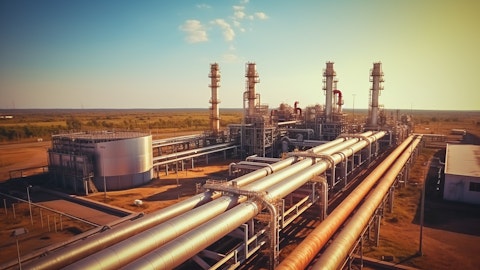And we’re going to take a similar approach. But I think what we’ve learned is that we must partner with one or two suppliers over multiple years to give them certainty on the revenue side, give us certainty on the components and labor on our side. So it’s been a successful model and it’s one we want to replicate as we advance the transition.
Harry Sideris: And I would add, Carly, it is getting better, but we’ve been able to put some processes in place using our scale and to be able to pre-plan and pre-order to really make sure that we have what we need when we need it to keep our investment plans going. And as we look forward, we’re going to continue to do that and partner like Brian mentioned, with our vendors to be able to stay ahead of the curve. But things are getting better, and we’re staying ahead of the curve there.
Carly Davenport: Got it. That’s really helpful. And then maybe just a quick follow-up on the balance sheet question. Can you just update us on where you currently stand? And then just relative to the walk that you sort of laid out last quarter, are any of the buckets that bridge the gap of getting to that 14% FFO to debt level changing at all relative to what we saw last quarter?
Brian Savoy: Carly, we really update the FFO once a year, but we are making progress with the rate cases from North Carolina being the largest single driver of improving FFO year-over-year. Deferred — fuel recovery is also on track. Those rates were updated, the last one happened in December for DEP North Carolina. So all the deferred fuel is on track to be fully recovered by the end of this year. We’re issuing the equity, the ATM and DRIP. We did 100 million in Q1, and we’ll continue that throughout the year to get to 500 million by the end of the year. And lastly, on the second half of the year, we expect to monetize tax credits from the IRA and that’s the last component. So we’re tracking exactly where we wanted to be at the end of the first quarter and is looking clear in sight.
Carly Davenport: That’s great. Thank you so much for that color.
Brian Savoy: Thank you.
Operator: And our next question is from Jeremy Tonet with JPMorgan. Please go ahead.
Jeremy Tonet: Hi, good morning.
Brian Savoy: Good morning.
Jeremy Tonet: I just wanted to follow up with the proposed gas additions as you laid out there. Just wondering how you see, I guess, incremental gas flowing into your territories given the difficulties we’ve seen in building new pipelines in different parts of the country. So just wondering how you think about this at that point?
Lynn Good: Jeremy, thank you. Making sure that we have adequate supply for any new source of generation is a part of the assignment. And so we have been at work over the course of 2023 and putting in place agreements that we believe will not only continue to strongly support the existing gas in our area, but also allow us to expand. And this is something that is closely monitored by the North Carolina Commission and will be Indiana as well as we continue diversification there. But we feel like we’ve got a credible plan in place, and it will be executed over the number of years, fully recognizing that it takes a lot of work with stakeholders to not only build the generation, but working with our partners who are putting pipeline infrastructure in place to make sure that the stakeholder concerns and needs are being met and so we’re confident we’ve got a plan in place we can execute.
Jeremy Tonet: Got it. And then — maybe just diving into load growth expectations. Just wondering if we could go a little bit further, I think, in the quarter, commercial was up 3.5%, industrials were down 2.5%. If you could touch based on that as well as, I guess, what specific things you see materializing over the balance of the year to accelerate the growth as you talk about a back half of ’24 increase?
Brian Savoy: Jeremy, it’s a good item to talk through. And on the commercial growth, we saw strength across our regions in the commercial sector. Data center growth was a key driver in that in the quarter, and we expect that to continue throughout the year. On the industrial side of things, we have some plants that are retooling for new products. So they’re offline in the first quarter. And they signalled to us that, look, this is a temporary thing, and we’re going to be changing our lines and by mid-Q2, late Q2, we’re coming back on in full. And we’re talking to these customers on a frequent basis to ensure we’re there to meet their needs when they need it, and they’re tracking on our plan. And we kind of expected this trend to continue because we saw this lag in industrial last year, and we thought by mid-2024, we’d see the tide turn.
And then lastly, economic development projects that are coming online in 2024. Those were slated for the second half as well, and those are tracking as planned. So we are on track for our 2% growth in 2024, and we’ll keep you apprised as we learn more.
Jeremy Tonet: Got it. Thank you for that.
Operator: This concludes the Q&A session. So I’ll hand the call back over to Lynn Good for any closing remarks.
Lynn Good: Thank you, and thanks to all of you. Thanks for your interest in Duke Energy. As always, we’re available for follow-on questions, and I appreciate your investment. Thanks for joining today.
Operator: This concludes today’s call. Thank you for joining. You may now disconnect your lines.
Follow Duke Energy Corp (NYSE:DUK)
Follow Duke Energy Corp (NYSE:DUK)
Receive real-time insider trading and news alerts





